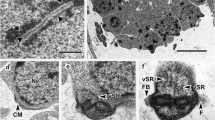Summary
Testes of the pond snail, Cipangopaludina malleata Reeve, were fixed in 1% osmium tetroxide, 3% permanganate, or 4% formaldehyde followed by 1% osmium tetroxide, each being buffered to pH 7.2 with Veronal-acetate or Sörensen's phosphate buffer. On the other hand, testes fixed with 4% formaldehyde adjusted to pH 7.2 with 0.075 M Na-cacodylate were incubated in Novikoff-Goldfischer medium for demonstrating thiamine pyrophosphatase, uridine or inosine diphosphatase, uridine monophosphatase or adenosine triphosphatase. The specimens incubated were postfixed in 1% osmium tetroxide buffered to pH 7.2 with Veronal-acetate buffer. Thin sections of the epoxy Epon resin-embedded tissue were stained either singly with saturated aqueous uranyl acetate or doubly with saturated aqueous uranyl acetate followed by lead citrate.
In a concentric lamellar structure consisting of the granular endoplasmic reticulum in the cytoplasm of early atypical spermatids, disappearance of ribosomes attached to the outer surface of cisternae seems to have initiated at the central part of the structure, and the cisterna-attached ribosomes seem to participate in the formation of dense granules appearing in the vesicles representing the endoplasmic reticulum of atypical spermatids.
The Golgi apparatus of the atypical spermatids in the advanced stages of development is composed of at least three different layers, the central part consisting of an amorphous material, the following lamellar and vesicular elements, and the peripheral fine vesicles.
It has been assumed that the mechanism by which the nucleic acid, especially DNA is converted into the polysaccharide might be attributed to the function of the Golgi apparatus, because the transformation of dense granules into less dense granules as well as diphosphatase activities have been detected within the Golgi apparatus.
Similar content being viewed by others
References
Caro, L. G., and G. E. Palade: Protein synthesis, storage, and discharge in the pancreatic exocrine cell. An autoradiographic study. J. Cell Biol. 20, 473–495 (1964).
Gall, J. G.: Centriole replication. A study of spermatogenesis in the snail Viviparus. J. biophys. biochem. Cytol. 10, 163–193 (1961).
Hanson, J., J. T. Randall, and S. T. Baley: The microstructure of the spermatozoa of the snail Viviparus. Exp. Cell Res. 3, 65–78 (1952).
Luft, J. H.: Permanganate — a new fixative for electron microscopy. J. biophys. biochem. Cytol. 2, 799–802 (1956); 9, 409–414 (1961).
Meek, G. A., and S. Bradbury: Localization of thiamine pyrophosphatase activity in the Golgi apparatus of a mollusc, Helix aspersa. J. Cell Biol. 18, 73–85 (1963).
Novikoff, A. B., and S. Goldfischer: Nucleosidediphosphatase activity in the Golgi apparatus and its usefulness for cytological studies. Proc. nat. Acad. Sci. (Wash.) 47, 802–810 (1961).
—, and W.-Y. Shin: The endoplasmic reticulum in the Golgi zone and its relations to microbodies, Golgi apparatus and autophagic vacuoles in rat liver cells. J. Microscop 3, 187–206 (1964).
Palade, G. E.: A study of fixation for electron microscopy. J. exp. Med. 95, 285–298 (1952).
Reynolds, E. S.: The use of lead citrate at high pH as an electron-opaque stain in electron microscopy. J. Cell Biol. 17, 208–212 (1963).
Watson, M. L.: Staining of tissue sections for electron microscopy with heavy metals. J. biophys. biochem. Cytol. 4, 475–478 (1958).
Yasuzumi, G.: Spermatogenesis in animals as revealed by electron microscopy. I. Formation and submicroscopic structure of the middle-piece of the albino rat. J. biophys. biochem Cytol. 2, 445–450 (1956).
—: Spermatogenesis in animals as revealed by electron microscopy. XII. Light and electron microscope studies on spermiogenesis of Cipangopaludina malleata Reeve. J. Ultrastruct. Res. 7, 488–503 (1962).
—: Spermiogenesis in animals as revealed by electron microscopy. X. The fine structure and function of endoplasmic reticulum and of peculiar bodies appearing in atypical maturing spermatids and nutritive cells of Cipangopaludina malleata Reeve. Amer. J. Anat. 115, 431–472 (1964).
—: Electron microscope studies on animal cell nuclei. [Japanese.] Acta anat. Nipponica 41, 143–144 (1966).
—, H. Fukui, M. Yoshida, and W. Matsuzaki: Electron microscope studies on atypical spermatids of Cipangopaludina malleata Reeve. VI. Int. Congr. Electron. Microscopy, vol. 2, p. 631–632. Kyoto: Maruzen Co. 1966.
—, Y. Nakai, and K. J. Lee: Electron microscope studies on the localization of reaction product of thiamine pyrophosphatase in spermatids of the mouse and crayfish. J. Electron Microscopy 14, 351–352 (1965).
—, and C. Oura: Differential analysis by various fixation techniques of structures present in developing spermatids of the silkworm. Nature (Lond.) 204, 1197–1198 (1964a).
—: Spermatogenesis in animals as revealed by electron microscopy. XII. Formation of a tubular structure and two bands in the developing spermatid of the silkworm, Bombyx mori Linné. Z. Zellforsch. 64, 210–226 (1964b).
—, and R. Sugihara: The fine structure of nuclei fixed by a double fixation procedure. Exp. Cell Res. 33, 578–580 (1964).
—, and H. Tanaka: Spermatogenesis in animals as revealed by electron microscopy. VI. Researches on the spermatozoon dimorphism in a pond snail, Cipangopaludina malleata. J. biophys. biochem. Cytol. 4, 621–632 (1958).
Author information
Authors and Affiliations
Additional information
This study was supported by Grant GM-8327-06 from the United States Public Health Service.
Rights and permissions
About this article
Cite this article
Yasuzumi, G., Lee, K.J., Fukui, H. et al. Spermatogenesis in animals as revealed by electron microscopy. Zeitschrift für Zellforschung 80, 353–369 (1967). https://doi.org/10.1007/BF00339328
Received:
Issue Date:
DOI: https://doi.org/10.1007/BF00339328




